https://www.youtube.com/watch?v=IS8F31Xx11c
How to Cook Noodles in a Rice Cooker!
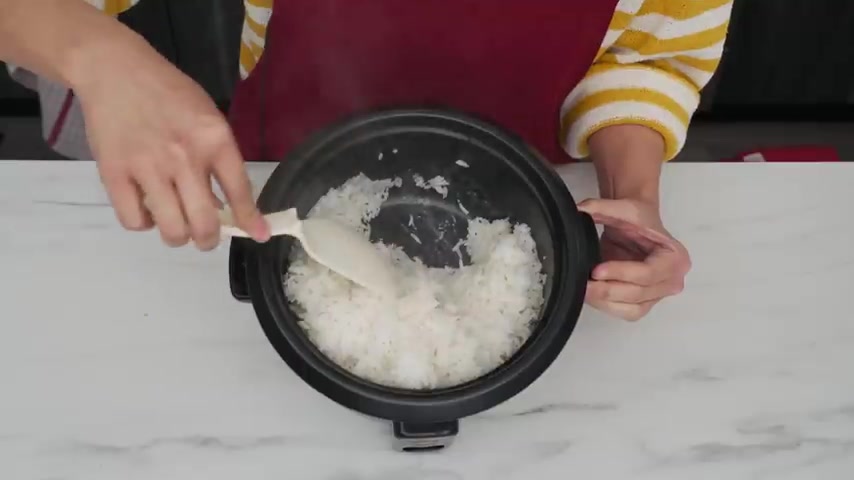
So at welcome to Hot Thai kitchen .
So I recently came across a way to cook noodles in a rice cooker .
And it kind of blew my mind because I always thought of a rice cooker as an appliance only for rice and rice based dishes .
But you can saute things , cook noodles and finish a whole dish in it without using the stove once .
So today , I'm going to go into a deep dive into how and why it works and then when it does not work .
And as an example , I'm going to show you how to make one of my absolute favorite noodle dishes in a rice cooker .
Let's talk about why we would even want to do this in the first place .
What problem does this solve ?
And to answer that question , we need to know how rice cookers work .
Rice cookers turn themselves off when the temperature at the bottom of the pot rises above a certain level .
And when does the temperature rise , when the water has all been absorbed into the rice ?

Because the present of water keeps the temperature low .
So when you cook rice or in this case , noodles on the stove top , you have to turn it off at the right time .
And if the heat is too high or you took too long , you forgot about it , then you get the burnt bottom that I think we've all done at some point in time .
But when you use a rice cooker , you don't have to worry about it .
It'll turn itself off when the time is done and then it takes all the guess , work out of the process .
So that means that the kind of dishes we're talking about today are the ones that end up dry at the end .
So we're not talking about noodles , soup or like noodles with lots of sauce in it .
Now , you can still do those in a rice cooker , but this is just going to behave like a regular pot on the stove .
So it's not much of a benefit .
Unless somehow you find yourself without a stove , then you can do those in a rice cooker too .
Let's talk types of rice cooker .
Now , any kind of rice cooker will work in theory .

But because we're gonna be doing some sauteing herbs in here and we're not cooking rice , you kind of have to know the quirks of your particular rice cooker .
First , these basic one button rice cookers are great .
However , if you've got a really old one , like this vintage one , the inner pot tends to be aluminum , which is fine , it'll cook fine , but noodles tend to stick to this material .
So if possible , these nonstick ones are better .
The second quirk is , most rice cookers have the spring loaded button at the bottom that requires enough weight , pushing down on it in order for it to cook .
Now , this is to prevent you from accidentally turning it on without anything in it .
For some rice cookers such as these two , the weight of the inner pot alone is enough to trigger it .
OK .
With these two , but with some rice cookers such as this one , which is by the way , the cheapest one at the drugstore , um the inner pot is so light that it it's not heavy enough , right ?
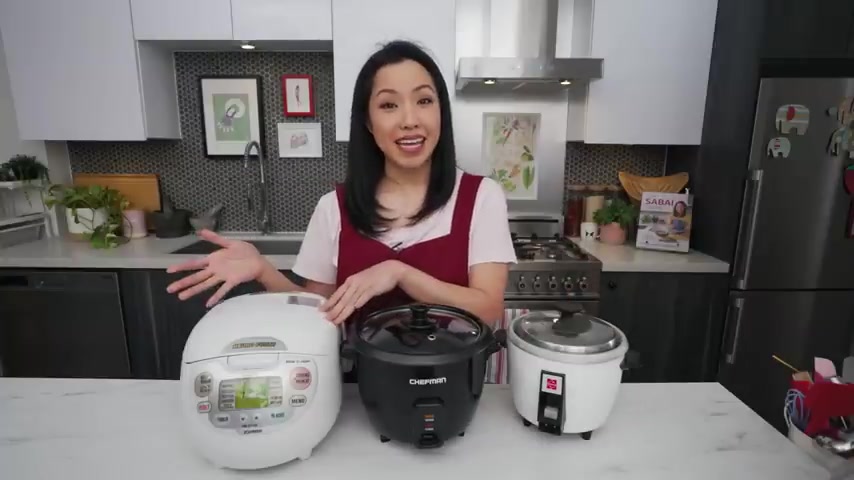
So in the beginning when we don't have much stuff in here , I actually need to keep those on in order for it to cook .
It's a slight annoyance , but there's an easy fix and I will show you how we do it .
Finally , these fancy rice cookers , they will work , but they're a little too smart for our purpose .
They heat up very slowly and they've even got a rest period at the end before the finish .
Bell will sound .
Both of these features are great if you're cooking rice .
But for noodles , we don't really need it .
So if you've got one of these , check out the blog post and I will talk through some ways around it .
Let's talk noodles .
The best kind of noodles hands down for this technique are these glass noodles because they are extremely forgiving .
It's hard to overcook them .
They can cook perfectly without having to constantly be stirred all the time .
They have a neutral flavor .
So it will work with all sorts of seasoning and they can go in raw and they'll cook right .
There's no precooking required .
Ok .
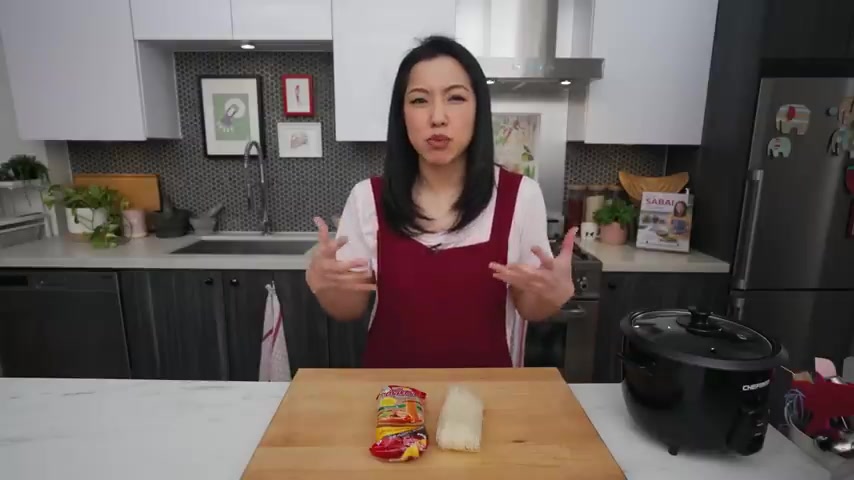
Now , I will talk about options for using other noodles at the end of the video because it'll just make more sense once you see how the cooking goes .
And once again , I am using our friend and sponsor Pine brand glass noodles , which are made from 100% mung bean starch .
That 100% is responsible for a chewy and elastic texture .
And also the reason why these are hard to overcook for the demo .
I'm making glass noodles , shrimp and ginger or I have a stovetop version of this dish already and I'll link to below but don't get hung up on the exact ingredients .
You can totally change them up .
This is more about the methods .
First , we have to soak our glass noodles for 10 minutes to fully rehydrate them .
Now , the sauce I'm going to mix together oyster sauce , soy sauce , black or dark soy sauce for some color sugar , toasted sesame oil and some water .
I'm also gonna add a little bit of shrimp paste in oil to um up that shrimp flavor a bit .
Again , this is just an example .

You can change up the seasonings but do keep the amount of water consistent .
Once the noodles are soaked and drained , I'm just gonna cut them in half or a third to make them a little easier to eat and then add them to the sauce for the protein .
I'm using deveined but shell on shrimp and the shell will add flavor and also help protect the shrimp from over cooking too quickly .
I'm also using larger shrimp .
So they'll cook at the same rate as our noodles , mix the shrimp in with the sauce .
And then that's if you want to use other proteins , I will include instructions in the blog post linked below for the aromatics .
I'm using ginger garlic , cilantro stems , crushed Sichuan peppercorns and white pepper .
But again , this can be anything you want time to cook .
So first we need some fat in the rice cooker .
Vetch oil is fine , but I'm going with rendered bacon fat for some extra indulgence .
Plain pork belly is fine , but bacon is convenient .

Then all of our aromatics also go in .
Now for this rice cooker , I have to put the lid on before pressing cook as we discussed .
But if your rice cooker doesn't need the lid on , you don't have to cover it at this point .
Once things are sizzling go in and give it a stir and let it cook for about three minutes , stirring a couple four times in between to allow the aromatics to infuse into the oil .
If once you open the lid , your rice cooker , clicks off , just do your stirring and then click the cook button again .
When you close the lid , it's a slight annoyance , but no big deal .
Once it smells really good , I'm gonna use tongs to put in just the noodles first and then pour in the shrimp and the sauce in after .
So that the shrimp are sitting on top .
This is so that the noodles have full access to the liquid at the bottom of the pot .
I'm gonna spread the shrimp out into one layer , close the lid and then let the rice cooker do its thing until it clicks off .

But after about four minutes , you do want to come back in and give the noodles a stir to redistribute the sauce and then while I'm at it , I'm just gonna flip the shrimp so they cook more evenly and shell on shrimp are very slippery and extremely hard to flip .
Just fy I and it's done .
Oh my God .
This is so life changing .
Like when I used to make this dish on the stovetop before I realized this was an option .
This used to be the most paranoid causing dish ever because like one minute too long and the bottom would be score .
So I'm like constantly like checking it .
So like this , like the fact that I can walk away , it's just life changing and also university students everywhere .
If you don't have a stove , if you've got a rice cooker .
Now you can eat more than just ramen noodles .
OK .
Let's check when it clicks off .
It theoretically should be done .
Yeah .
Looks good .

Oh , it smells good .
Now , we do want to give it a stir bottom .
Looks good .
No burning , no sticking .
Now , at this point , if you find that your noodles are undercooked or anything like that , probably you didn't put enough liquid .
Just go ahead and add a splash of water and keep it cooking a little bit more .
It's an easy fix .
Ok .
Now , to finish this off , I'm gonna add some celery leaves and some cilantro .
You can do green onions if you want .
And that's ready to serve .
By the way , this trend started in Thailand because in Thailand , there are a lot of really small condos without a real kitchen .
And so a lot of people are living with just a rice cooker and a microwave as their only appliance .
So there are a lot of innovation around what you can do with a rice cooker and that's how kind of this came to be .
Hm .
So this dish can be eaten with rice .
But today because I forgot to cook rice .
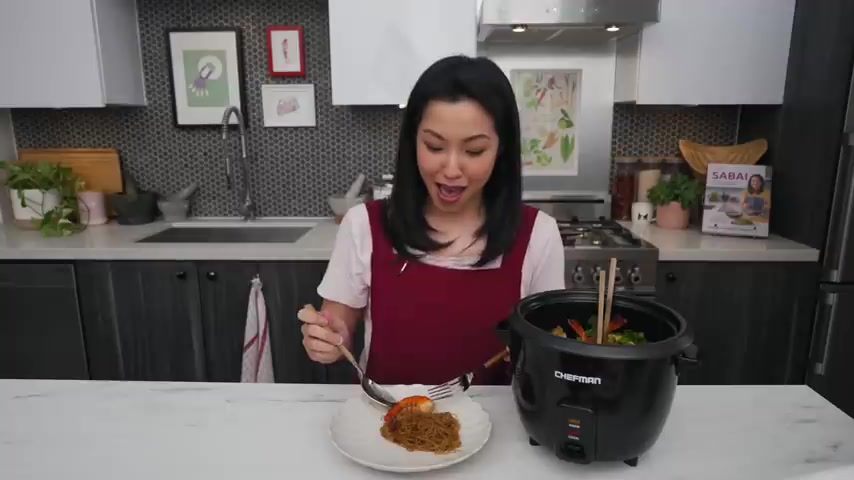
Uh Even though we have three rice cookers in this studio , uh we're gonna just have it by itself and the shrimp , you know what , forget the shrimp .
I know the shrimp is good , but this is all about the noodles , right ?
So let's eat some noodles .
Mm .
It's perfect .
Mm .
So good .
Hm .
Now that you've seen how it works , let's talk about other noodle options .
So I have tried this with rice noodles , specifically these rice vermicelli and it worked but it wasn't as ideal because rice noodles have a smaller window of good doneness .
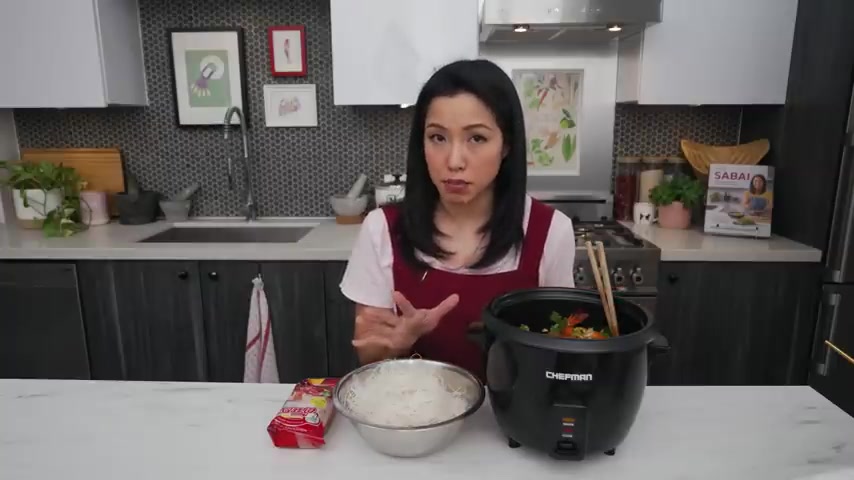
So they really do better with more stirring to make sure the liquid and the sauce is evenly distributed .
So , if you do it , I would just go in there more often and stir , especially in the beginning when there's still a lot of liquid pooling at the bottom .
So it's not quite as hands off , but it's possible .
And if you want to use rice noodles , they do need to be fully rehydrated just like we did with the glass noodles .
But they do tend to take much longer to soak all the details will be in the block .
So check that out .
If you want to try rice noodles , egg noodles , I haven't tried , but only because in theory , I just don't think it'll work because egg noodles before we stir fry them , for example , they have to be fully cooked , boiled in boiling water .
You can't just stick them in raw like we did with the glass noodles .
So you could still do it .
But what you'd have to do is actually boil the egg noodles in the rice cooker .
So treat this like a regular pot , drain them and then stir fry them in the rice cooker again .
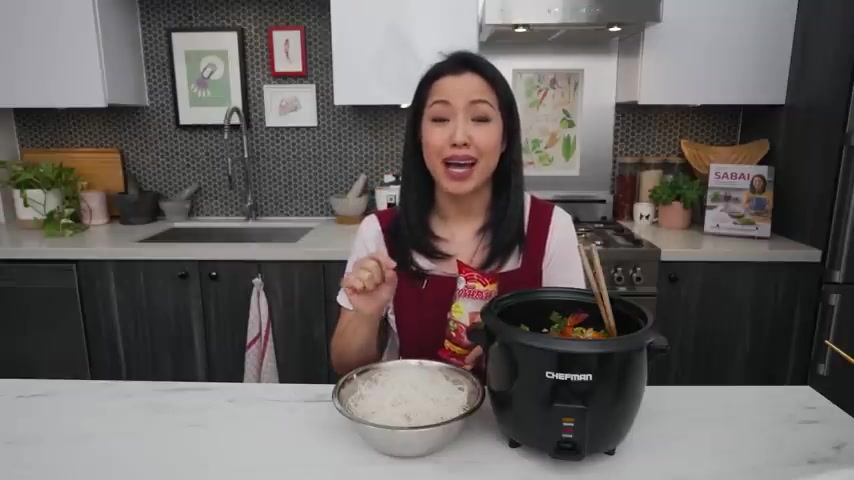
But then that's really no different from doing it stovetop .
But if you , for some reason find yourself in a hotel room with only a rice cooker , you can make it work glass noodles are particularly suited for .
This method is because they can go into the rice cooker raw .
They don't need to be stirred all the time and they have a very wide window of acceptable doneness .
So a little too much water , too little water , they're gonna be fine .
And there's a reason why in Thailand glass noodles are the only noodles that we use for this method of cooking .
And as a bonus , they also have a lower glycaemic index than rice noodles .
So it's also a little healthier .
So the recipe as always will be on hot kitchen dot com .
And if you want to use other ingredients , other vegetables , other proteins do read the blog post , I will give guidance on that .
So you can apply this technique with different ingredients successfully .

A special thanks to all of our Patreon members who help support the show if you want to know what that's all about and how you can get direct access to me and many , many other benefits .
You can check out the link in the description below .
I hope you found this as interesting as I did and I will see you next time .
So at
Are you looking for a way to reach a wider audience and get more views on your videos?
Our innovative video to text transcribing service can help you do just that.
We provide accurate transcriptions of your videos along with visual content that will help you attract new viewers and keep them engaged. Plus, our data analytics and ad campaign tools can help you monetize your content and maximize your revenue.
Let's partner up and take your video content to the next level!
Contact us today to learn more.